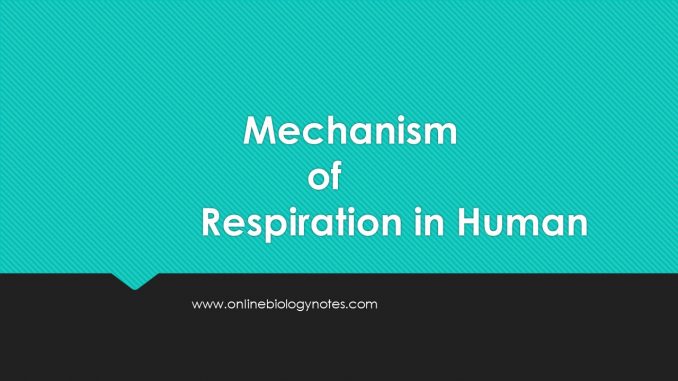
Entire physiology of respiration involves following steps
- Breathing or pulmonary ventilation
- External respiration
- Transport of O2 to tissue
- Internal respiration
- Transport of CO2 from tissue
1. Breathing or Pulmonary ventilation
- This is movement of air into and out of the lungs.
- Breathing supplies oxygen to the alveoli, and eliminates carbon dioxide.
- The main muscles involved in breathing are the intercostal muscles and the diaphragm.
- There are 11 pairs of intercostal muscles occupying the spaces between the 12 pairs of ribs. They are arranged in two layers, the external and internal intercostal muscles.
- The diaphragm is a dome-shaped muscular structure separating the thoracic and abdominal cavities.
- Breathing depends upon changes in pressure and volume in the thoracic cavity. Since air flows from an area of high pressure to an area of low pressure, changing the pressure inside the lungs determines the direction of airflow.
- Breathing involves two process
i. Inspiration
- It takes place when the volume of thoracic cavity is increased and the air pressure is decreased.
- Simultaneous contraction of the external intercostal muscles and the diaphragm expands the thorax.
- As the diaphragm + external intercostals contracts (moves downward) lung volume increases.
It involves following events
- First of all, external intercoastal muscle contracts and internal intercoastal muscles relaxes.
- Due to contraction of external intercoastal muscles, ribs is pulled upward, resulting in increase in thoracic cavity size
- The thoracic cavity further enlarges due to contraction of diaphragm, lowering the diaphragm and increases the size of thoracic cavity.
- With increase in size of thorax, lungs expand simultaneously.
- As lungs expands, the air pressure is reduced inside, so equalize the pressure, atmospheric air rushes inside the lungs
ii. Expiration
It takes place when the size of thoracic cavity is reduced and air pressure is increased.
involves following events
- The internal intercoastal muscle contracts and external intercoastal muscles relaxes.
- Due to contraction of internal intercoastal muscle, ribs are pulled inward, resulting in decrease in size of thoracic cavity
- Furthermore the diaphragm is pushed upward due to its relaxation
- With the decrease in size of thoracic cavity, lungs is compressed
- As lungs is compressed, pressure increases, so the air is forced outside.
2. External respiration
- This is the exchange of gases by diffusion between alveoli and blood in the alveolar capillaries, across respiratory membrane.
- Diffusion of oxygen and carbon dioxide depends on pressure differences, e.g. between atmospheric air and the blood, or blood and the tissues.
- Gas exchange during the respiration process takes place in the alveolus at its surface that separates the alveolus with the capillary.
- The exchange of O2 and CO2 occurs through diffusion which is the net movement of gas molecules from a region that has a higher partial pressure to another region that has a lower partial pressure.
- The venous blood in alveolar capillaries contains high level of CO2 and low level of O2.
- Co2 then diffuses from higher level (venous blood) to lower level (alveoli) until equilibrium is maintained. By the same process O2 diffuses from alveoli to venous blood until equilibrium.
3. Transport of Oxygen to tissue
- Oxygen is carried in the blood to the tissue in two from:
i) Oxyhaemoglobin (98.5%): it is a chemical combination of O2 with haemoglobin
Hb4 + 4O2………………………………………… Hb4O8 (oxyhaemoglobin)
ii) Solution in plasma water (1.5%): O2 dissolve in plasma of blood and carried to tissues.
- when the level of O2 is high in blood, it combines with haemoglobin to from oxyhaemoglobin.
- Oxyhaemoglobin is unstable, and under certain conditions readily dissociates releasing oxygen. Factors that increase dissociation include low O2 levels, low pH and raised temperature.
4. Internal respiration
- Internal respiration is exchange of gases which takes places in tissue, so also known as cellular respiration.
- In tissue, oxygen carried in the form of Oxyhaemoglobin get dissciated to liberating free O2.
Hb4O8———dissociates to give ——— Hb + O2
- The free O2 then oxidized the glucose in the presence of respiratory enzymes to liberate CO2, water and energy.
C6H12O6 + 6O2 ———- 6CO2 + 6H2O + Energy
- Energy is utilized by the tissue for its vital activities, while the CO2 is diffused from the tissue.
5. Transport of Carbondioxide from tissue to lungs
- Carbon dioxide is one of the waste products of metabolism.
- It is excreted by the lungs and is transported by three mechanisms:
i) as Carbonic acid (H2CO3) (7%): some CO2 dissolved in the plasma to form carbonic acid
- carbondioxide mixed with water of blood plasma to form carbonic acid.
- CO2+ H2O——————H2CO3
ii) bicarbonate ions (HCO3−) in the plasma (70%)
- carbonic acid formed in blood plasma quickly ionizes to from bicarbonates and hydrogen ions in the presence of enzyme carbonic anhydrase.
- CO2 + H2O—————H+ + HCO3-
- bicarbonate ions combined with sodium or potassium present in blood to form sodium bicarbonate (NaHCO3) or Potasssium bicarbonate (KHCO3) and transported in this form
iii) as carbaminohaemoglobin (23%): some CO2 combines with Haemoglobin to form carbaminohaemoglobin in RBCs.
- CO2 + NHbNH2————–HbNH.COOH (carbaminohaemoglobin).
finally, CO2 are carried to lungs and expelled out by expiration process of breathing.
